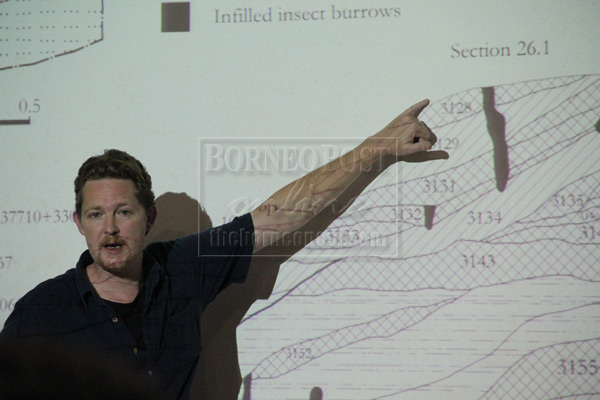
INTERESTING: Stimpson shares the statistical data from his research on bird and bat bones recovered from the Great Cave of Niah at the Sarawak Biodiversity Centre.
KUCHING: Similar or identical species of cave-dwelling birds and bats in the Great Cave of Niah 50,000 years ago still exist today, revealed archeologist Dr Christopher M Stimpson yesterday.
Stimpson, who had completed his PhD research on bird and bat bones recovered from the Niah Cave under the University of Cambridge, said there was evidence of large population of bats and swiftlets for such a long time.
“The cave’s ecosystem which has been described in this part of the world is not a recent phenomenon for it is quite ancient ecosystem as well,” he added.
“The bats and swiftlets are primary contributors to the cave ecology,” he said in his public awareness talk on ‘Paleozoological Perspectives on Biological Conservation in Niah National Park: Evidence from the Great Cave’ held at the Sarawak Biodiversity Centre in Jalan Puncak Borneo here.
The talk discussed results from an analysis of bird (Aves) and bat (Mamalia: Chiroptera) bones that were recovered during archeological excavations of the Niah Cave in archeological sequences dating from 50,000 years to 350 years before the present time.
Continuing on, he said the birds will go out and catch insects, return to the cave and deposit the energy into the cave environment in the form of guano.
Guano is the faeces and urine of bats and birds, which is a highly effective fertiliser due to its high phosphorous and nitrogen content.
“Guano is relied upon about by diverse insect communities, which houses predators both invertebrate, something like shrews and geckos,” he said.
“The swiftlets and bats are also important in the diet of local predatory birds like hawks and owls,” he added.
Interestingly, he also highlighted that there were no changes on the wing length of the swiftlets despite the landscape as well as the climate and environment changes in the past 50,000 years.
With these data, Stimpson recommended for more studies to be done especially on the carrying capacity of the national park as well as the dietary of the black nest swiftlets.
It will be very useful to get more data, Stimpson emphasised, considering that the local environment has been forested throughout this time to further provide on biodiversity conservation in the National Park.
Stimpson was originally trained as a zoologist (BSc University of Leeds), then specialised in paleozoology (MSc University of York) before completing his PhD under the University of Cambridge.
His principal research areas are paleoecology and the use of Quaternary-age paleozoological data sets to inform on the conservation of extant populations of animals and birds.
In addition to his research specialisms, Stimpson has worked extensively as a field archeologist in North Africa, Southeast Asia and Central and Eastern Europe.
